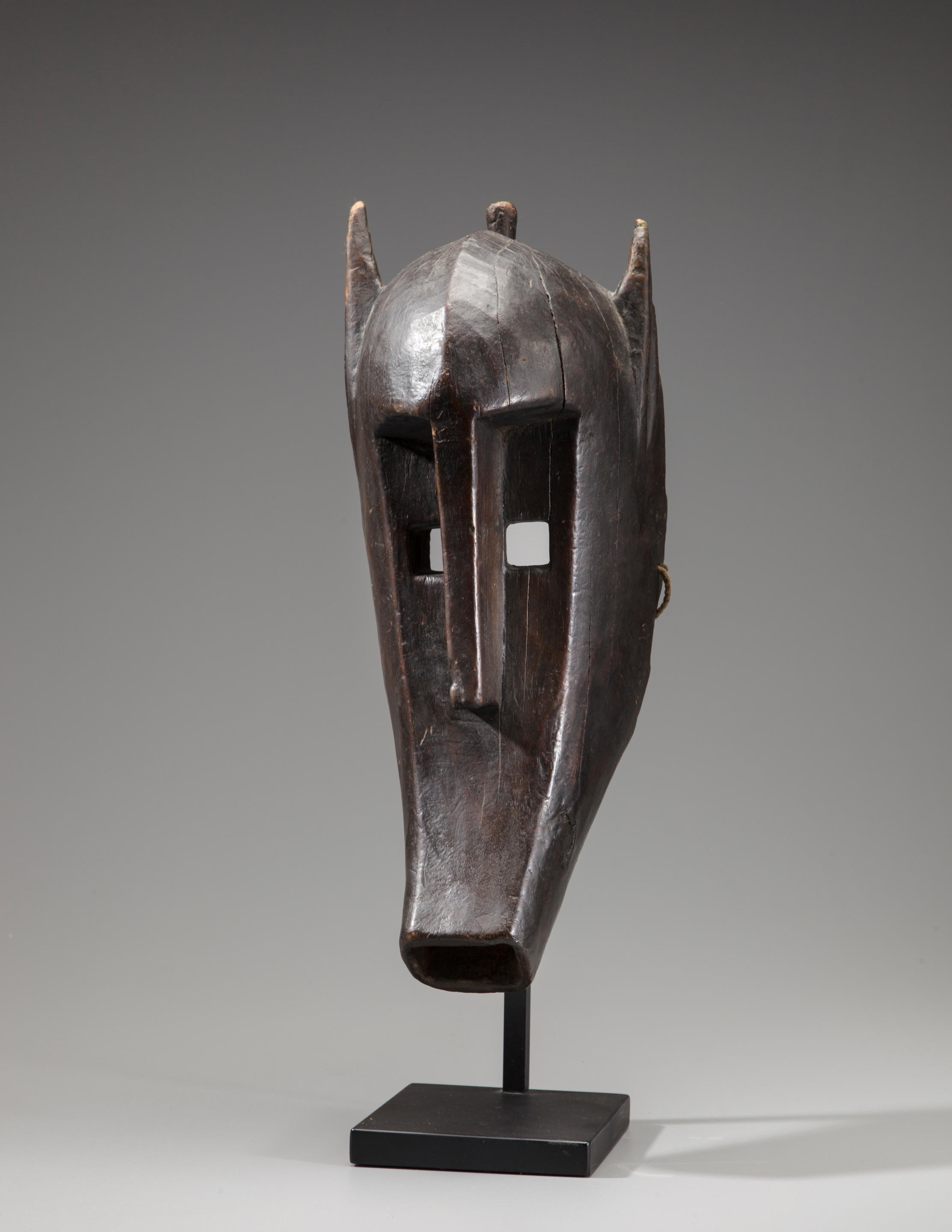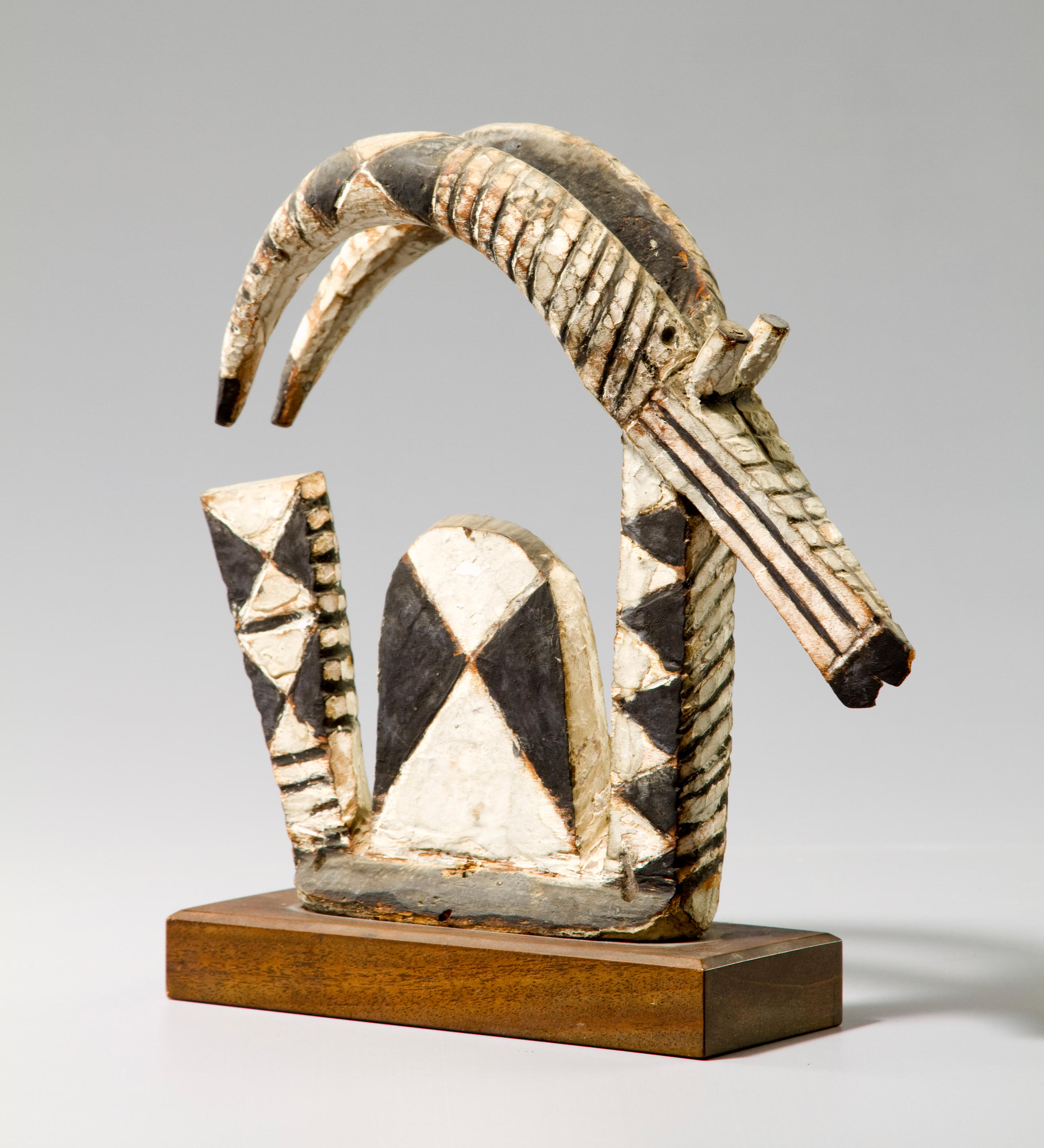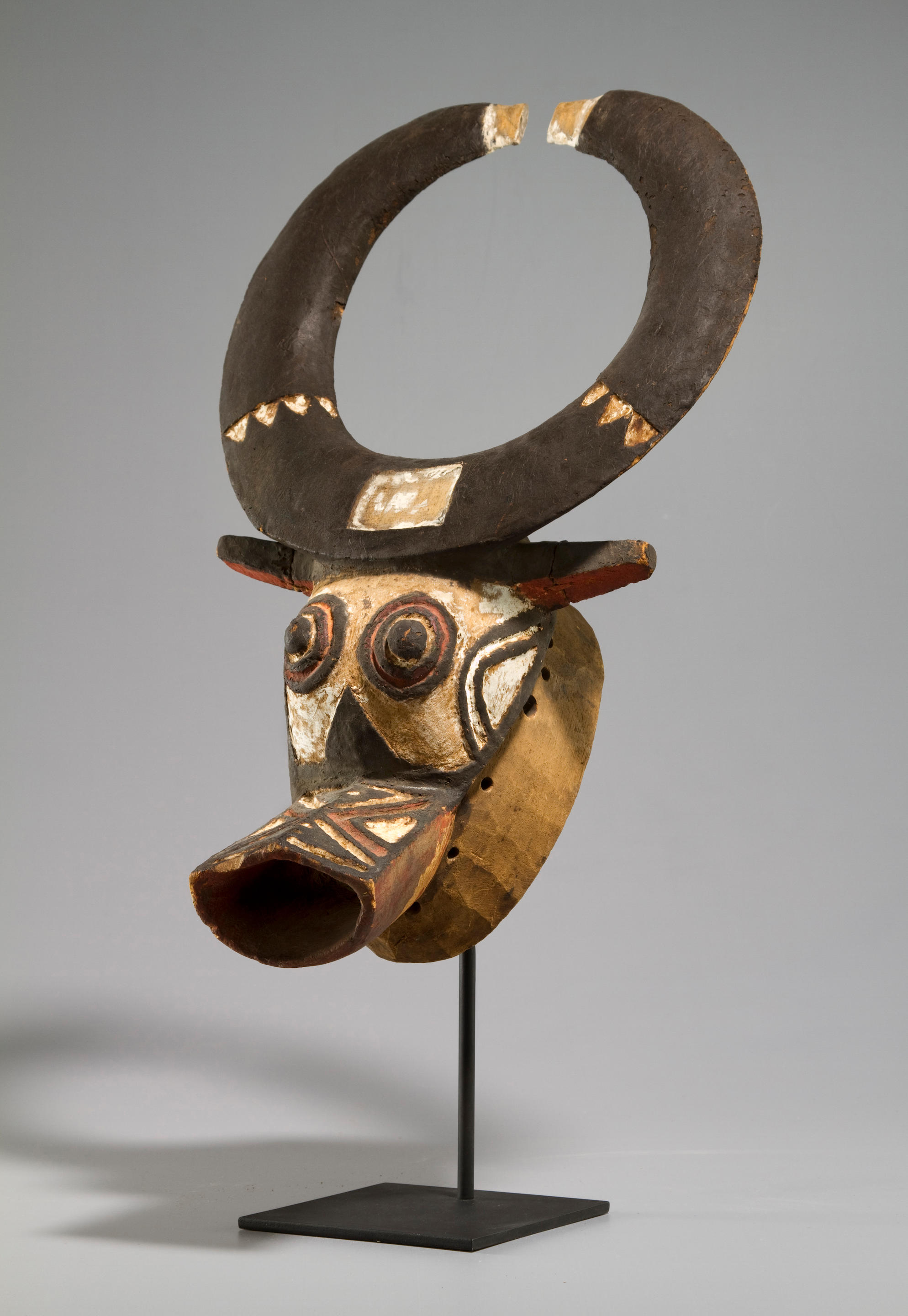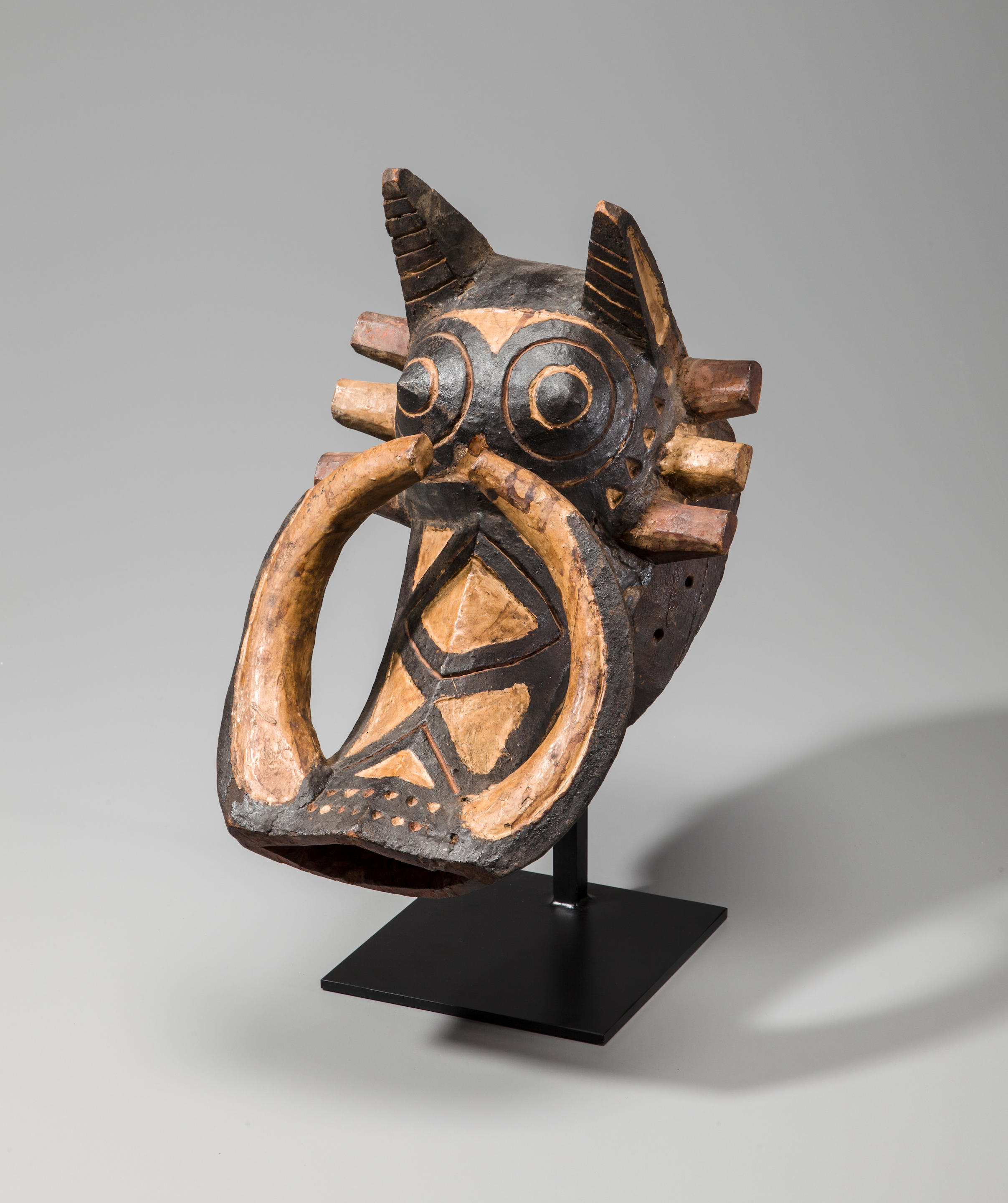height 24 1/8in (61.4cm) Wood Provenance: Henri Kamer, New York and Paris Private Collection, New York An exquisitely carved wooden equestrian figure with seated horseman and stylized horse. The elongated male rider having a small prognathous head with scooped facial plane. His face with ovoid, downturned eyes bisected by a long nose and small mouth, C-shaped ears in strong relief with scarification on the sides of the head below the temples, under the eyes and on both sides of the lower nose areas. He wears a small hat and has a powerful neck. An amulet for protection is worn at his chest. Rounded, strong shoulders curving into the upper arms with scarification on both. Above the elbows, the rider wears carved, biconical armbands. Both elbows bent into the lower arms; right arm extending to his hand carrying a stylized rifle and lower left arm extended and attached to the horse's head. Long, backwardly arched torso with protruding abdomen connecting to short, bent legs with small feet. Defined buttocks seated on the saddle form. The horse's head with full carved face having rounded eyes, long nose and slightly open mouth on three sides of the jaw with raised lips. Front and rear horse's legs are fused to form plank-like trapezoidal shapes. Fully rounded and pointed downturned horse's tail in rear. Overall black/brown encrusted surface with glossy patina. Cf. Chemeche, George, The Horse Rider In African Art, London, 2011: illustrated p 78: full page showing another figure (h 22.5 in) (see illustration below of figure missing the right arm) and p 79; full page showing detail of the rider's head and upper body. This figure is probably from the same workshop as the one offered. "The horse which symbolizes power, is overpowered by the authority of the rider. To increase this power visually and emotionally, to single out the relationship of authority between ruler and ruled, between deity and devotee, the artist is able to deploy his skill to create a sculpture of unexpected, astonishing dimension. The disproportion between the horse, whose size is mercilessly shrunk, and the rider whose body is extremely elongated offers a dramatic yet harmonious sculptural structure... In the late nineteenth century, warriors on horseback were a frequent sight in Senufo villages. Some of these riders were soldiers in the army of Dyula empire-builder Samori Ture, pursuing Senufo captives and destroying their homes and fields. Others were Senufo leaders, defending their villages against the invaders. The memory of these powerful horsemen has left its mark on Senufo art. Ridden by foreign conquerors or local rulers, horses are synonymous with aggression, power, and wealth in Senufo art and culture... Poro, an initiation society that is mandatory for all Senufo men, provides the framework and hierarchy for social, political and religious activities in Senufo villages. Sandogo, the woman's society found in all Senufo communities, is concerned with maintaining good relationships with the spirit world and ensuring the propriety of marriages in the human one. Images of the horses and riders can be found in both poro's public art forms and the more private sandogo art forms... Men in their twenties and early thirties who were members of the senior grade, known as tyolobele, comprised the infantry. Their elders who had completed all the initiation phases of poro, served as cavalry. In the Senufo region in the late nineteenth century, horsemen were both defenders and attackers, and the attackers were both Senufo and foreign... As is typical of Senufo wood sculpture, the play of convex and concave curves provides movement and vitality to these images. The riders sit proudly, often with exaggeratedly erect posture and broad curved shoulders. Often the prognathic jaw echoes the forward curve of the torso, adding to the figures assertive expression. The horses themselves often have a swayed back, repeating the curves seen in the riders. The horse's front legs a
height 24 1/8in (61.4cm) Wood Provenance: Henri Kamer, New York and Paris Private Collection, New York An exquisitely carved wooden equestrian figure with seated horseman and stylized horse. The elongated male rider having a small prognathous head with scooped facial plane. His face with ovoid, downturned eyes bisected by a long nose and small mouth, C-shaped ears in strong relief with scarification on the sides of the head below the temples, under the eyes and on both sides of the lower nose areas. He wears a small hat and has a powerful neck. An amulet for protection is worn at his chest. Rounded, strong shoulders curving into the upper arms with scarification on both. Above the elbows, the rider wears carved, biconical armbands. Both elbows bent into the lower arms; right arm extending to his hand carrying a stylized rifle and lower left arm extended and attached to the horse's head. Long, backwardly arched torso with protruding abdomen connecting to short, bent legs with small feet. Defined buttocks seated on the saddle form. The horse's head with full carved face having rounded eyes, long nose and slightly open mouth on three sides of the jaw with raised lips. Front and rear horse's legs are fused to form plank-like trapezoidal shapes. Fully rounded and pointed downturned horse's tail in rear. Overall black/brown encrusted surface with glossy patina. Cf. Chemeche, George, The Horse Rider In African Art, London, 2011: illustrated p 78: full page showing another figure (h 22.5 in) (see illustration below of figure missing the right arm) and p 79; full page showing detail of the rider's head and upper body. This figure is probably from the same workshop as the one offered. "The horse which symbolizes power, is overpowered by the authority of the rider. To increase this power visually and emotionally, to single out the relationship of authority between ruler and ruled, between deity and devotee, the artist is able to deploy his skill to create a sculpture of unexpected, astonishing dimension. The disproportion between the horse, whose size is mercilessly shrunk, and the rider whose body is extremely elongated offers a dramatic yet harmonious sculptural structure... In the late nineteenth century, warriors on horseback were a frequent sight in Senufo villages. Some of these riders were soldiers in the army of Dyula empire-builder Samori Ture, pursuing Senufo captives and destroying their homes and fields. Others were Senufo leaders, defending their villages against the invaders. The memory of these powerful horsemen has left its mark on Senufo art. Ridden by foreign conquerors or local rulers, horses are synonymous with aggression, power, and wealth in Senufo art and culture... Poro, an initiation society that is mandatory for all Senufo men, provides the framework and hierarchy for social, political and religious activities in Senufo villages. Sandogo, the woman's society found in all Senufo communities, is concerned with maintaining good relationships with the spirit world and ensuring the propriety of marriages in the human one. Images of the horses and riders can be found in both poro's public art forms and the more private sandogo art forms... Men in their twenties and early thirties who were members of the senior grade, known as tyolobele, comprised the infantry. Their elders who had completed all the initiation phases of poro, served as cavalry. In the Senufo region in the late nineteenth century, horsemen were both defenders and attackers, and the attackers were both Senufo and foreign... As is typical of Senufo wood sculpture, the play of convex and concave curves provides movement and vitality to these images. The riders sit proudly, often with exaggeratedly erect posture and broad curved shoulders. Often the prognathic jaw echoes the forward curve of the torso, adding to the figures assertive expression. The horses themselves often have a swayed back, repeating the curves seen in the riders. The horse's front legs a















Try LotSearch and its premium features for 7 days - without any costs!
Be notified automatically about new items in upcoming auctions.
Create an alert